FDA指南征求意见
美国FDA指南-中文版

《美国FDA认证与申办指南》权威资讯系列《合成原料药DMF起草大纲》使用说明:1、本大纲是为了帮助我公司客户把握DMF的整体内容而准备的,由于DMF内容繁多,从整体上了解内容框架和组成部分,对于理解FDA对DMF的要求和意图非常有必要;2、根据FDA的要求,凡是本大纲提到的内容,原料药制造商均应该提供。
因此,客户务必依照规定提供尽可能详细的内容。
3、本大纲的内容和相关要求能够确保客户目前的运作达到FDA的cGMP标准,因此,准备DMF的过程,也使客户按照FDA的要求进行整改和提高的过程,这些都为FDA未来的现场检查打下良好基础;4、凡是本大纲中提到的非技术性具体内容要求,请参照本公司专有的与此大纲配套的相关DFM指导性文件,包括《FDA药物主文件指南》、《关于在药品递交中递交的有关原料药生产的支持文件的指南》、《药物申办中质量管理方面通用技术文件格式与内容要求》;5、凡是本大纲中提到的技术性具体内容要求,如杂质、稳定性、验证等具体技术要求,请参照本公司专有的FDA相关技术标准文件,包括《原料药认证指南》、《制剂认证指南》、《化学药物稳定性指南》、《化学药物杂质指南》、《化学药物化验与合格参数指南》、《化学药物验证指南》等;《合成原料药DMF起草大纲》一、公司和生产场地的基本描述1、第一类的DMF文件建议由位于美国之外的人提供,以帮助FDA对他们的生产设施进行现场检查。
DMF文件应描述生产场地、设备能力、生产流程图等。
A Type I DMF is recommended for a person outside of the United States to assist FDA in conducting on site inspections of their manufacturing facilities. The DMF should describe the manufacturing site, equipment capabilities, and operational layout.2、第一类的DMF文件对美国国内设施通常不需要,除非该设施没有登记并定期接受检查。
FDA国外药厂检查指南
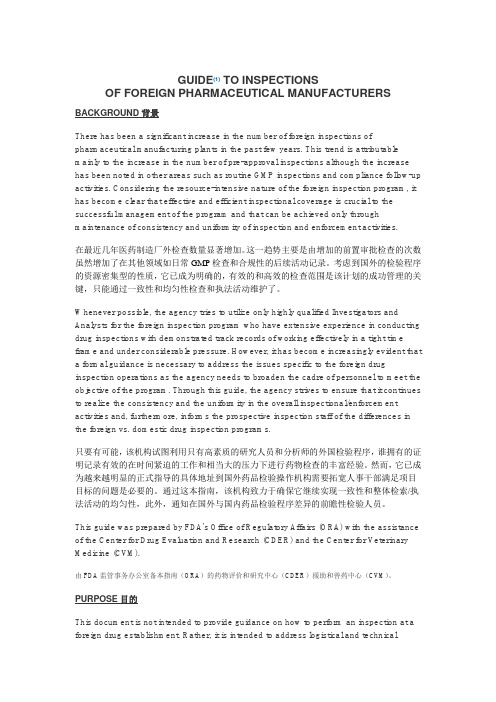
GUIDE(1) TO INSPECTIONSOF FOREIGN PHARMACEUTICAL MANUFACTURERS BACKGROUND背景There has been a significant increase in the number of foreign inspections of pharmaceutical manufacturing plants in the past few years. This trend is attributable mainly to the increase in the number of pre-approval inspections although the increase has been noted in other areas such as routine GMP inspections and compliance follow-up activities. Considering the resource-intensive nature of the foreign inspection program, it has become clear that effective and efficient inspectional coverage is crucial to the successful management of the program and that can be achieved only through maintenance of consistency and uniformity of inspection and enforcement activities.在最近几年医药制造厂外检查数量显著增加。
这一趋势主要是由增加的前置审批检查的次数虽然增加了在其他领域如日常GMP检查和合规性的后续活动记录。
FDA药物临床前指南-Guidance for Industry Unmarketed Investigational Drugs
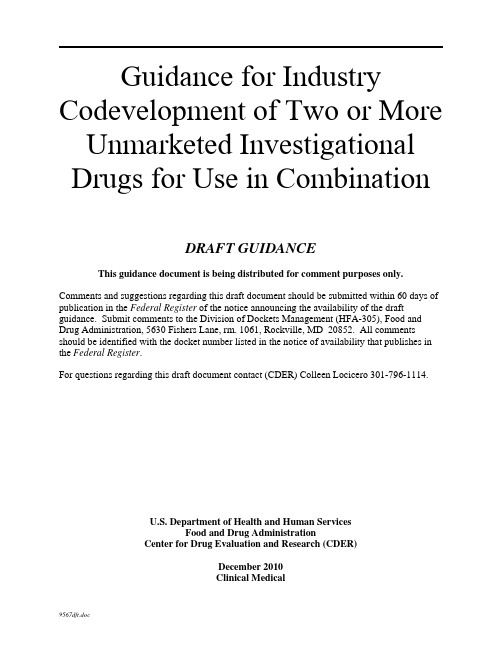
Codevelopment of Two or More Unmarketed Investigational Drugs for Use in CombinationDRAFT GUIDANCEThis guidance document is being distributed for comment purposes only. Comments and suggestions regarding this draft document should be submitted within 60 days of publication in the Federal Register of the notice announcing the availability of the draft guidance. Submit comments to the Division of Dockets Management (HFA-305), Food and Drug Administration, 5630 Fishers Lane, rm. 1061, Rockville, MD 20852. All comments should be identified with the docket number listed in the notice of availability that publishes in the Federal Register.For questions regarding this draft document contact (CDER) Colleen Locicero 301-796-1114.U.S. Department of Health and Human ServicesFood and Drug AdministrationCenter for Drug Evaluation and Research (CDER)December 2010Clinical MedicalCodevelopment of Two or More Unmarketed Investigational Drugs for Use in CombinationAdditional copies are available from:Office of CommunicationsDivision of Drug Information, WO51, Room 220110903 New Hampshire Ave.Silver Spring, MD 20993Phone: 301-796-3400; Fax: 301-847-8714druginfo@/Drugs/GuidanceComplianceRegulatoryInformation/Guidances/default.htmU.S. Department of Health and Human ServicesFood and Drug AdministrationCenter for Drug Evaluation and Research (CDER)December 2010Clinical MedicalTable of Contents 1234 5 6 7 8 910111213141516171819202122 I.INTRODUCTION (1)II.BACKGROUND (2)III.DETERMINING WHETHER CODEVELOPMENT IS AN APPROPRIATEDEVELOPMENTOPTION (2)IV.NONCLINICAL CODEVELOPMENT (3)A.Demonstrating the Biological Rationale for the Combination (3)B.Nonclinical Safety Characterization (3)V.CLINICAL CODEVELOPMENT (4)A.Early Human Studies (Phase 1) (4)1.Safety of the Individual Components (4)2.Safety and Dosing of the Combination (5)B.Clinical Pharmacology (5)C.Proof of Concept Studies (Phase 2) (6)D. Confirmatory Studies (Phase 3) (8)VI.REGULATORY PROCESS ISSUES IN CODEVELOPMENT (8)A. Early Interaction with FDA (8)B. IND Submissions and Marketing Applications (9)beling Issues (9)D.Pharmacovigilance (9)232425262728Guidance for Industry1Codevelopment of Two or More Unmarketed Investigational Drugsfor Use in Combination2930 This draft guidance, when finalized, will represent the Food and Drug Administration’s (FDA’s) current31 thinking on this topic. It does not create or confer any rights for or on any person and does not operate to32 bind FDA or the public. You can use an alternative approach if the approach satisfies the requirements of33 the applicable statutes and regulations. If you want to discuss an alternative approach, contact the FDA34 staff responsible for implementing this guidance. If you cannot identify the appropriate FDA staff, call35 the appropriate number listed on the title page of this guidance.36373839404142434445464748495051525354555657 I. INTRODUCTIONThis guidance is intended to assist sponsors in the codevelopment2 of two or more novel (not previously marketed) drugs to be used in combination to treat a disease or condition. The guidance provides recommendations and advice on how to address certain scientific and regulatory issues that will arise during codevelopment. It is not intended to apply to development of fixed-dose combinations of already marketed drugs or to development of a single new investigational drug to be used in combination with an approved drug or drugs. The guidance is also not intended to apply to vaccines, gene or cellular therapies, blood products, or medical devices.3FDA’s guidance documents, including this guidance, do not establish legally enforceable responsibilities. Instead, guidances describe the Agency’s current thinking on a topic and should be viewed only as recommendations, unless specific regulatory or statutory requirements are cited. The use of the word should in Agency guidances means that something is suggested or recommended, but not required.1 This guidance has been prepared by the Office of Medical Policy in the Center for Drug Evaluation and Research (CDER) at the Food and Drug Administration.2Codevelopment herein refers to the concurrent development of two or more drug products with the intent that the products be used in combination to treat a disease or condition.3 For purposes of this guidance, the term drug includes therapeutic biological products that are regulated by CDER. Consult the Therapeutic Biologics web page for further information on the types of biological products to which this guidance applies:/Drugs/DevelopmentApprovalProcess/HowDrugsareDevelopedandApproved/ApprovalApplications/T herapeuticBiologicApplications/default.htmII. BACKGROUND585960616263646566676869707172737475767778798081828384858687888990919293949596979899 100 101 102 103 Combination therapy is an important treatment modality in many disease settings, including cancer, cardio-vascular disease, and infectious diseases. Recent scientific advances have increased our understanding of the pathophysiological processes that underlie these and other complex diseases. This increased understanding has provided further impetus for new therapeutic approaches using combinations of drugs directed at multiple therapeutic targets to improve treatment response or minimize development of resistance. In settings in which combination therapy provides significant therapeutic advantages, there is growing interest in the development of combinations of investigational drugs not previously developed for any purpose.Because the existing developmental and regulatory paradigm focuses primarily on assessment of the effectiveness and safety of a single new investigational drug acting alone, or in combination with an approved drug, FDA believes guidance is needed to assist sponsors in the codevelopment of two or more unmarketed drugs. Although interest in codevelopment has been most prominent in oncology and infectious disease settings, codevelopment also has potential application in other therapeutic settings. Therefore, this guidance is intended to describe a high-level, generally applicable approach to codevelopment of two or more unmarketed drugs. It describes the criteria for determining when codevelopment is an appropriate option, makes recommendations about nonclinical and clinical development strategies, and addresses certain regulatory process issues. III. DETERMININGWHETHERCODEVELOPMENT IS AN APPROPRIATE DEVELOPMENT OPTIONConcurrent development of two or more novel drugs for use in combination generally will provide less information about the safety and effectiveness of the individual drugs than would be obtained if the individual drugs were developed alone. How much less will vary depending on a variety of factors, including the stage of development at which the individual drug components cease to be studied independently. For example, in codevelopment scenarios in which rapid development of resistance to monotherapy is a major concern, it may not be possible or appropriate to obtain clinical data for the individual components of the combination beyond phase 1 testing. Because codevelopment will generally provide less information about the safety and effectiveness of the individual drugs, it will present greater risk compared to development of an individual drug. Therefore, FDA believes that codevelopment should ordinarily be reserved for situations that meet the following criteria:•The combination is intended to treat a serious disease or condition.•There is a compelling biological rationale for use of the combination (e.g., the agents inhibit distinct targets in the same molecular pathway, provide inhibition of both aprimary and compensatory pathway, or inhibit the same target at different binding sites to decrease resistance or allow use of lower doses to minimize toxicity).• A preclinical model (in vivo or in vitro) or short-term clinical study on an established biomarker suggests that the combination has substantial activity and provides greater thanadditive activity or a more durable response (e.g., delayed resistance) compared to the individual agents alone. 104105106107108109110111112113114115116117118119120121122123124125126127128129130131132133134135136137138139140141142143144145146 • There is a compelling reason for why the agents cannot be developed individually (e.g., monotherapy for the disease of interest leads to resistance and/or one or both of the agents would be expected to have very limited activity when used as monotherapy). FDA recommends that sponsors consult with FDA on the appropriateness of codevelopment before initiation of clinical development of the combination. IV. NONCLINICAL CODEVELOPMENT A. Demonstrating the Biological Rationale for the Combination The biology of the disease, pathogen, or tumor type should be sufficiently understood to provide a plausible biological rationale for the use of combination therapy to treat the disease or condition. For example, in an oncology setting the biological rationale may be to intervene at different steps in the cell proliferation pathway. The biological rationale for a combination anti-infective therapy may be to target different metabolic pathways or different steps in the replication cycle of the pathogen to reduce the chance of developing resistance to the therapy or increase efficacy in treating disease caused by resistant organisms (e.g., multidrug-resistant atypical tuberculosis). Sponsors should develop evidence to support the biological rationale for the combination in an in vivo (preferable) or in vitro model. The model should compare the activity of the combination to the activity of the individual components. Ordinarily, the model should demonstrate that, compared to the individual components, the combination has substantial activity and provides greater than additive activity or a more durable response in a pathophysiological process considered pertinent to the drug’s intended use in humans. An animal model of activity generally would not be necessary. However, if there is an animal model relevant to the human disease, valuable activity data, as well as information about the relative doses of the drugs, might be obtained from evaluating the combination in that model. B. Nonclinical Safety Characterization For detailed recommendations regarding nonclinical safety characterization for two or more investigational drugs to be used in combination, sponsors should consult the recently revised International Conference on Harmonisation (ICH) Guidance on Nonclinical Safety Studies.4 Section XVII of that guidance (Combination Drug Toxicity Testing) includes a discussion of nonclinical safety studies appropriate in a combination drug development setting involving two early stage entities. The ICH guidance defines early stage entities as compounds with limited clinical experience (i.e., phase 2 studies or less), so the discussion is specifically applicable to the4 Guidance for Industry: M3(R2) Nonclinical Safety Studies for the Conduct of Human Clinical Trials andMarketing Authorization, January 2010 (this guidance is a revision of 1997 ICH guidance M3: Nonclinical Safety Studies for the Conduct of Human Clinical Trials for Pharmaceuticals).147 148 149 150 151 152 153 154 155 156 157 158 159 160 161 162 163 164 165 166 167 168 169 170 171 172 173 174 175 176 177 178 179 180 181 182 183 184 185 186 187 188 189 190 191 192 type of development described in this guidance. In situations in which it is possible to obtain only limited clinical data for the individual drugs, additional nonclinical data for the individual drugs or combination may be needed before beginning human studies with the combination. (e.g., see section V.A.1).V. CLINICAL CODEVELOPMENTThis section provides a general roadmap and guiding principles for concurrent clinical development of two or more investigational drugs to be used in combination. It includes recommendations for characterizing the clinical safety and effectiveness of the combination and, to the extent needed or possible, the individual components of the combination.Note: The appropriate review division should always be consulted on the specifics of a given clinical development program.A. Early Human Studies (Phase 1)The main objectives of early studies in humans are to characterize the safety and pharmacokinetics of the individual components and then the combination and to provide data to support appropriate dosing for the combination in phase 2 testing.1. Safety of the Individual ComponentsWhenever possible, the safety profile of each individual drug should be characterized in phase 1 studies in healthy volunteers in the same manner as would be done fordevelopment of a single drug, including determination of the maximum tolerated dose(MTD), the nature of the dose limiting toxicity (DLT), and pharmacokinetic parameters.If there is a useful measure (e.g., biomarker) of pharmacologic activity, it will also beimportant to determine dose-response for that measure. If testing in healthy volunteers is not possible (e.g., if nonclinical data suggest a drug may be genotoxic or otherwiseunacceptable for studies in healthy volunteers), the safety profile of the individual drugs should be evaluated in patients with the disease of interest. These safety data will guide decisions in later studies about starting doses, dose escalation increments, and final dose selection.If it is not possible to characterize the safety of the individual drugs in humans (e.g.,where drug toxicity prevents use of healthy volunteers and monotherapy would beunethical in patients with the disease of interest), the sponsor should conduct nonclinical studies of the combination to support initial dosing of the combination in humans.The nonclinical data for the combination should include pharmacokinetic (absorption,distribution, metabolism, and excretion) and toxicokinetic data and appropriatebiomarker/target inhibition, if relevant.2. Safety and Dosing of the Combination 193194195 196 197 198 199 200 201 202 203 204 205 206 207 208 209 210 211 212 213 214 215 216 217 218 219 220 221 222 223 224 225 226 227 228 229 230 231 232 233 234 235 236 237For initial human effectiveness studies of the combination, the combination starting dose, dosing escalation intervals, and doses to be used in dose-response studies should bedetermined based on phase 1 safety data for the individual components, if available. Ifphase 1 safety data for the components are unavailable, nonclinical data for thecombination will be needed to determine the initial combination dose in humans (seeprevious paragraph). Phase 1 safety studies of the combination could also be conducted — for example, sequential testing in which subjects get drug A, then drug B, then AB — to support dosing in subsequent studies.B. ClinicalPharmacologyThe sponsor should conduct the same clinical pharmacology studies for each of the individual drugs in the combination as would be done if the drugs were being developed separately. In general, such studies include the assessment of bioavailability, characterization of pharmacokinetics, mass balance, the evaluation of effects of intrinsic (such as renal impairment and hepatic impairment) and extrinsic (such as food effect and drug interactions) factors on pharmacokinetics or pharmacodynamics, and exposure-response. Studies to address intrinsic and extrinsic factors could be conducted with the combination instead of the individual drugs.The evaluation of drug interaction potential follows the same sequence as in other development programs; results of in vitro drug metabolism and drug transporter studies inform the need for in vivo drug interaction studies. The role of pharmacogenomics should be investigated and incorporated into the combination drug development plan to identify potential sources of pharmacokinetic or pharmacodynamic variability.Dose-response should be evaluated for each drug of the combination. The results of such studies should be used to determine doses to further explore for the combination. If the drug products cannot be administered alone, various doses of each drug administered as the combination should be assessed.If one drug has no activity or minimal activity by itself, dose-response should be assessed when the drug products are administered in combination using a number of doses of the active drug and the inactive drug. The same approach should be used in evaluating dose-response for the combination of drugs where each drug has minimal activity when used alone.In addition to evaluating dose-response, response should be evaluated with respect to systemic drug concentration to provide insight into efficacy and safety as a function of drug exposure. Concentration-response assessments should be done in both phase 2 and phase 3 trials. To increase exposure ranges in phase 3 and to further assess dose-response, the incorporation of more than one dose of each of the drugs used in the combination in the phase 3 trials should be considered.C. Proof of Concept Studies (Phase 2) 238239240 241 242 243 244 245 246247 248 249 250 251 252 253 254 255 256 257 258 In general, phase 2 testing should accomplish the following to the extent needed for a given combination (e.g., to the extent not sufficiently established by existing data): •Demonstrate the contribution of each component of the combination to the extent possible and needed (given available nonclinical and pharmacologic data);•Provide evidence of the effectiveness of the combination; and•Optimize the dose or doses of the combination for phase 3 trials.The amount and types of clinical data needed and appropriate study designs will vary depending on the nature of the combination being developed, the disease, and other factors. For the types of combinations contemplated by this guidance, it will often be inappropriate to use monotherapy treatment arms in studies of the disease of interest, or it will be possible to administer the components of the combination as monotherapy only for short durations. In these circumstances, the study design typically employed to determine the contributions of the components to the combination — a four-arm factorial design comparing the combination to individual components and placebo or standard of care (SOC) therapy (AB v. A. v. B v. placebo or SOC) — will have limited utility. The following scenarios illustrate possible phase 2 study designs for combinations of two investigational drugs in different situations.Scenario 1: The components of the combination cannot be administered individually259 260261 262 263 264 265 266 267 268 269 270 271 272 273 274 275 276 277 278If in vivo or in vitro models, or phase 1 or other early clinical studies make clear that the components of the combination cannot be administered individually in clinical trials inthe disease of interest (e.g., because such testing would involve administering treatment known to be ineffective as monotherapy), or can’t be administered as monotherapy forthe duration needed to evaluate effectiveness (e.g., because of rapid development ofresistance), proof-of-concept evidence for the combination ordinarily should come froma study directly comparing the combination (AB) to SOC. Alternatively, if SOC isknown to be an effective therapy (not solely palliative), an add-on design could be used comparing the combination plus SOC to SOC alone.In some resistance scenarios, it may be possible to administer the individual drugs in acombination as monotherapy for a short duration, but long enough to establish proof ofconcept in humans. For example, direct-acting antivirals (DAAs) to treat chronichepatitis C virus infection can be administered as monotherapy for three days to establish antiviral activity and for initial dose exploration. For DAA studies of longer duration, the combination should be used or the individual components should be added to an activecontrol.55 See draft guidance for industry: Chronic Hepatitis C Virus Infection: Developing Direct-Acting Antiviral Agents for Treatment (section III. 4. b. – Phase 1b (proof-of-concept) trials) or consult the Division of Antiviral Drug Products in CDER for more specific recommendations.279 280 281 282 283 284 285 286 287 288 289 290 291 292 293 294 295 296 297 298 299 Scenario 2: Each drug alone has activity and can be administered individuallyIf in vivo or in vitro models, or phase 1 or other early clinical studies indicate that each drug has some activity, but the combination appears to have greater than additive activity, and rapid development of resistance is not a concern, a four-arm, phase 2 trial comparing the combination to each drug alone and to placebo or SOC (AB v. A v. B v. SOC or placebo6) should be used to demonstrate the contribution of the components to the combination and proof of concept. As noted above, if SOC is a known effective therapy, a study design in which each of the arms is added to SOC could be used (AB + SOC v. A + SOC v. B + SOC v. placebo + SOC).An adaptive trial design with the same four treatment arms might also be used where appropriate, initially using the treatment arms described above. The single-drug arms could be terminated early if it became clear that they had much less activity than the combination. These designs could demonstrate the activity of each component of (i.e., the contribution of each component to the combination) without exposing the large numbers of patients typically required for phase 3 trials to therapeutic products with inadequate activity. For these trials, it may not be necessary to use a clinical endpoint as a primary efficacy measurement. A credible pharmacodynamic or other biomarker, such as tumor response, may be adequate.300 301 302 303 304 305 306 307 308 309 310 311 312 313 314 315 316 317 318 Scenario 3: One drug is active alone and one is inactiveIf in vivo or in vitro models, or phase 1 or other early clinical studies suggest that one of the drugs is inactive or minimally active and one drug is modestly active, but the combination has substantial activity, the more active drug generally will require greater scrutiny and should ordinarily be studied as a single drug in a phase 2 study. The minimally active drug generally would not require study as a single drug beyond initial phase 1 safety studies. In this scenario, proof of concept and the contribution of each component could be demonstrated using a three-arm comparison of the active drug alone, SOC, and the combination (AB v. A v. SOC), or the combination and the individual drug added to SOC where SOC is a known effective therapy (AB + SOC v. A + SOC v. SOC). If the inactive drug in a combination is a pharmacokinetic or metabolic enhancer that contributes to the activity of the combination only by increasing the therapeutic concentrations of the active drug, human pharmacokinetic data may provide adequate evidence to support the enhanced activity of the combination and demonstrate the contribution of the inactive drug. A confirmatory study of the combination would usually be needed to provide evidence of effectiveness for the combination (see section V.D). Dose Finding319 320321 322Dose-finding studies could be very important to refine the combination dose or doses and select doses for phase 3 trials. Depending on the role of each component, it may be6 Note that the placebo arm is intended to show the effect size compared to non-treatment, not to show the contribution of each component.323 324 325 326 327 328 329 330 331 332 333 334 335 336 337 338 339 340 341 342 343 344 345 346 347 348 349 350 351 352 353 354 355 356 357 358 359 360 361 362 363 364 365 366 367useful to test multiple doses of both components to establish a best dose in terms of risks and benefits. If one component in a two-drug combination is more active than the other, it may be more important to study multiple doses of the more active drug (as part of thecombination). For the same reason, it may be more important to study multiple doses ofa drug that is significantly more toxic than the other component of the combination.Other study designs and types of studies also may be appropriate.D. Confirmatory Studies (Phase 3)If findings from in vivo or in vitro models and/or phase 2 trials adequately demonstrate the contribution of each component to the combination, phase 3 trials comparing the combination to SOC or placebo generally will be sufficient to establish effectiveness. If the contribution of the individual components is not clear and it is ethically feasible to use a component or components of the combination as monotherapy in a study arm, it may be necessary to demonstrate the contribution of the components in phase 3 studies (e.g., by use of a factorial design). For example, if phase 2 data do not provide sufficient evidence of the contribution of each component of a two drug combination, but provide strong evidence that the combination is superior to one of the components, a phase 3 trial comparing the combination to the more active component alone and SOC may be needed to demonstrate that the less active component contributes to the activity of the combination. In this and other situations, it will often be useful to study more than one dose of the more active drug in phase 3 studies.Unexpected toxicity (e.g., serious adverse events observed at higher than expected rates) in phase 2 trials is a potential complication for development of a combination and progressing to phase 3 trials. If the toxicity can be attributed to one component of the combination, it may be possible to conduct phase 3 trials with the combination using a lower dose or doses of the more toxic component. If the toxicity cannot be attributed to an individual component of the combination, additional studies may be needed to identify the more toxic component and appropriate dosing for the combination before initiating phase 3 trials. The specifics of any phase 3 design should be discussed with the appropriate FDA review division at an End-of-Phase 2 meeting.VI. REGULATORY PROCESS ISSUES IN CODEVELOPMENTSponsors should consider a number of regulatory issues when planning the codevelopment of two or more novel drugs for use in combination. Key issues are outlined below.A. Early Interaction with FDASponsors are encouraged to communicate as early as possible (e.g., pre-IND meeting) with the appropriate FDA review division when considering codevelopment of innovative combination therapy. Sponsors also are encouraged to consult FDA frequently throughout the development process. We believe such communication will help facilitate development of the combination therapy.368 369 370 371 372 373 374 375 376 377 378 379 380 381 382 383 384 385 386 387 388 389 390 391 392 393 394 395 396 397 398B. IND Submissions and Marketing ApplicationsDecisions about the type of IND submission(s) and marketing application(s) needed (e.g., individual component submissions, combination submission) will depend on the sponsor's overall codevelopment and marketing strategy. Until FDA has more experience with codevelopment, FDA recommends that these decisions be made on a case-by-case basis in consultation with the appropriate review division.C. Labeling IssuesFDA also anticipates that the content of labeling for the combination and/or the components will be case specific, depending on the nature of the combination, the intended uses of the individual components, the marketing strategy, and other factors. Therefore, FDA does not believe it can provide generally applicable labeling guidance at this time. Again, we recommend consultation with the appropriate review division.D. PharmacovigilanceApplicants should develop a pharmacovigilance plan that takes into account the additional postmarket risks presented by initial marketing of two or more previously unapproved drugs for use in combination (compared to risks associated with marketing of a single drug). Risk will vary, depending on the nature of the combination and how the combination is marketed. The risk assessment should consider, among other things:•Potential for use of each drug individually;•Potential for use of any of the components of the combination in combinations with other drugs; and•Drugs likely to be co-administered with the combination.Applicants should discuss their pharmacovigilance plans with the appropriate review division and the Office of Surveillance and Epidemiology.。
FDA工业指南 非青霉素β内酰胺类药品防止交叉污染的指导原则2013.4
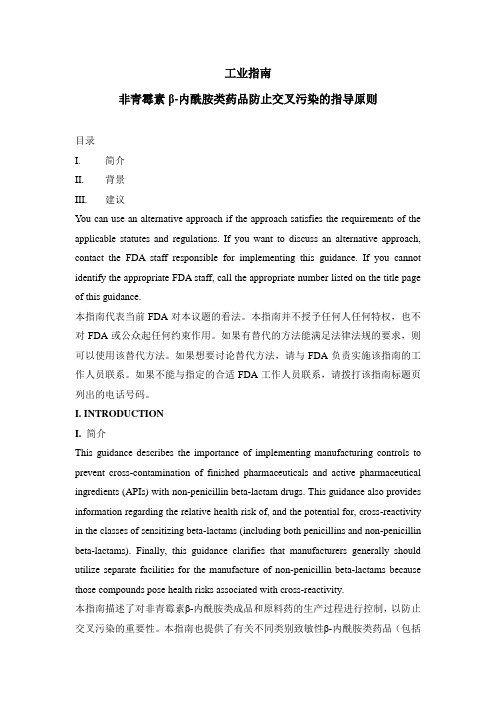
工业指南非青霉素β-内酰胺类药品防止交叉污染的指导原则目录I.简介II.背景III.建议You can use an alternative approach if the approach satisfies the requirements of the applicable statutes and regulations. If you want to discuss an alternative approach, contact the FDA staff responsible for implementing this guidance. If you cannot identify the appropriate FDA staff, call the appropriate number listed on the title page of this guidance.本指南代表当前FDA对本议题的看法。
本指南并不授予任何人任何特权,也不对FDA或公众起任何约束作用。
如果有替代的方法能满足法律法规的要求,则可以使用该替代方法。
如果想要讨论替代方法,请与FDA负责实施该指南的工作人员联系。
如果不能与指定的合适FDA工作人员联系,请拨打该指南标题页列出的电话号码。
I. INTRODUCTIONI. 简介This guidance describes the importance of implementing manufacturing controls to prevent cross-contamination of finished pharmaceuticals and active pharmaceutical ingredients (APIs) with non-penicillin beta-lactam drugs. This guidance also provides information regarding the relative health risk of, and the potential for, cross-reactivity in the classes of sensitizing beta-lactams (including both penicillins and non-penicillin beta-lactams). Finally, this guidance clarifies that manufacturers generally should utilize separate facilities for the manufacture of non-penicillin beta-lactams because those compounds pose health risks associated with cross-reactivity.本指南描述了对非青霉素β-内酰胺类成品和原料药的生产过程进行控制,以防止交叉污染的重要性。
FDA指南草案GDUFA
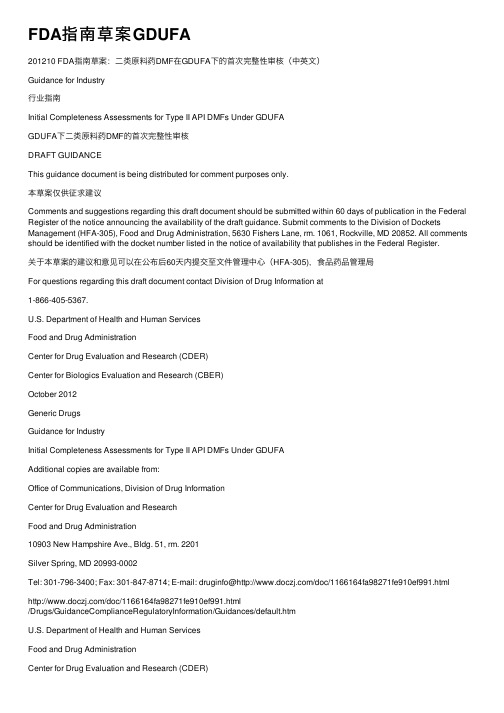
FDA指南草案GDUFA201210 FDA指南草案:⼆类原料药DMF在GDUFA下的⾸次完整性审核(中英⽂)Guidance for Industry⾏业指南Initial Completeness Assessments for Type II API DMFs Under GDUFAGDUFA下⼆类原料药DMF的⾸次完整性审核DRAFT GUIDANCEThis guidance document is being distributed for comment purposes only.本草案仅供征求建议Comments and suggestions regarding this draft document should be submitted within 60 days of publication in the Federal Register of the notice announcing the availability of the draft guidance. Submit comments to the Division of Dockets Management (HFA-305), Food and Drug Administration, 5630 Fishers Lane, rm. 1061, Rockville, MD 20852. All comments should be identified with the docket number listed in the notice of availability that publishes in the Federal Register.关于本草案的建议和意见可以在公布后60天内提交⾄⽂件管理中⼼(HFA-305),⾷品药品管理局For questions regarding this draft document contact Division of Drug Information at1-866-405-5367.U.S. Department of Health and Human ServicesFood and Drug AdministrationCenter for Drug Evaluation and Research (CDER)Center for Biologics Evaluation and Research (CBER)October 2012Generic DrugsGuidance for IndustryInitial Completeness Assessments for Type II API DMFs Under GDUFAAdditional copies are available from:Office of Communications, Division of Drug InformationCenter for Drug Evaluation and ResearchFood and Drug Administration10903 New Hampshire Ave., Bldg. 51, rm. 2201Silver Spring, MD 20993-0002Tel: 301-796-3400; Fax: 301-847-8714; E-mail: druginfo@/doc/1166164fa98271fe910ef991.html /doc/1166164fa98271fe910ef991.html/Drugs/GuidanceComplianceRegulatoryInformation/Guidances/default.htmU.S. Department of Health and Human ServicesFood and Drug AdministrationCenter for Drug Evaluation and Research (CDER)Center for Biologics Evaluation and Research (CBER)October 2012TABLE OF CONTENTS ⽬录I. INTRODUCTION 概述 (1)II. BACKGROUND 背景 (2)III. INITIAL COMPLETENESS ASSESSMENT ⾸次完整性审核 (2)A. Information Confirmed During the Initial Completeness Assessment 初审要确认的信息 (3)B. Check of Initial Completeness Assessment Elements 初审要素检查 (4)IV. INITIAL COMPLETENESS ASSESSMENT OUTCOMES初审结果 (4)V. API INFORMATION INCLUDED IN A GENERIC DRUG SUBMISSION仿制药申请中包括的原料药信息 (5)VI. SUMMARY总结 (5)DEFINITIONS定义 (6)APPENDIX 1:附件1 (7)Guidance for Industry[1]⾏业指南Initial Completeness Assessments for Type II API DMFsUnder GDUFAGDUFA下对⼆类原料药DMF的⾸次完整性审核I. INTRODUCTION 概述This draft guidance is intended for holders of Type II active pharmaceutical ingredient (API) drug master files (DMFs) that are or will be referenced in an abbreviated new drug application (ANDA) or an amendment or prior approval supplement (PAS) to an ANDA (generic drug submissions). The guidance explains that, beginning October 1, 2012, under the Generic Drug User Fee Amendments of 2012, commonly referred to as GDUFA.[2]本指南阅读对象为已经或将要被仿制药ANDA或其增补或预批准变更所引⽤的⼆类原料药DMF的持有⼈。
FDA行业指南中英对照待完成
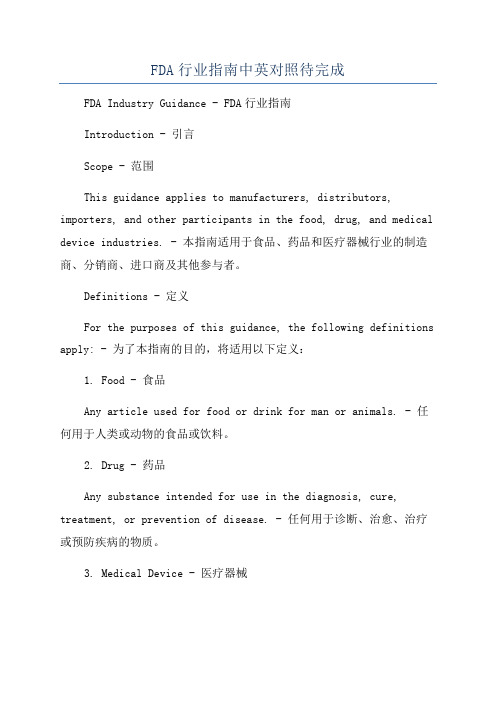
FDA行业指南中英对照待完成FDA Industry Guidance - FDA行业指南Introduction - 引言Scope - 范围This guidance applies to manufacturers, distributors, importers, and other participants in the food, drug, and medical device industries. - 本指南适用于食品、药品和医疗器械行业的制造商、分销商、进口商及其他参与者。
Definitions - 定义For the purposes of this guidance, the following definitions apply: - 为了本指南的目的,将适用以下定义:1. Food - 食品Any article used for food or drink for man or animals. - 任何用于人类或动物的食品或饮料。
2. Drug - 药品Any substance intended for use in the diagnosis, cure, treatment, or prevention of disease. - 任何用于诊断、治愈、治疗或预防疾病的物质。
3. Medical Device - 医疗器械Any instrument, apparatus, or device intended for use in the diagnosis, cure, mitigation, treatment, or prevention of disease. - 任何用于诊断、治愈、缓解、治疗或预防疾病的仪器、装置或设备。
4. Manufacturer - 制造商Product Quality Requirements - 产品质量要求Manufacturers should ensure that products meet the appropriate quality standards established by the FDA. - 制造商应确保产品符合FDA制定的适当质量标准。
201507FDA行业指南分析方法验证

201507FDA行业指南分析方法验证2015年7月,美国FDA (Food and Drug Administration) 发布了新的行业指南,介绍了药物和医疗器械领域的分析方法验证。
这个指南对于保证产品质量和确保公众安全具有重要意义。
本文将对该指南进行分析,并探讨其对行业的影响以及验证方法的重要性。
1. 简介验证是确保分析方法在实际使用中可靠有效的过程。
FDA的行业指南旨在为制药和医疗器械公司提供明确的准则,以确保他们的分析方法能够满足质量控制和监管要求。
这些准则适用于各种不同类型的分析方法,包括物理、化学、生物和微生物学方法。
2. 指南内容概述行业指南详细说明了验证过程的各个方面,包括确定适用性、验证方案、系统准备、执行验证、结果分析和文档记录等。
其中,关键的几个步骤将在下文中详细探讨。
3. 确定适用性在验证方法之前,首先需要确定该方法是否适用于特定的产品或测试要求。
这包括评估方法的准确性、灵敏度、特异性和稳定性。
通过这样的评估,可以确定方法是否足够可靠来提供准确的测试结果。
4. 验证方案验证方案是验证过程的蓝图,包括验证目标、测试范围、验证样品和测试计划等。
在制定验证方案时,需要考虑产品的特点、使用环境和监管要求。
一个详细而全面的验证方案可以确保全面有效地验证分析方法。
5. 系统准备在进行验证之前,需要确保验证所需的系统和设备处于适当的状态。
这包括系统的校准、验证设备的合格以及操作程序的准备等。
只有在系统准备充分的情况下,才能确保验证结果的准确性和可靠性。
6. 执行验证执行验证是验证过程的核心步骤。
这涉及到按照预定的方法和程序进行一系列测试,并记录结果。
测试的过程中需要注意各种潜在的干扰因素,如环境影响、操作人员技能和设备性能等。
7. 结果分析验证的结果需要进行详细的分析和评估。
这包括比较验证结果与预期结果,评估方法的准确性和可靠性,并确定是否需要进行进一步的调整或改进。
结果分析是验证过程结束后的一个重要环节,它为后续的质量控制和监管提供了重要的依据。
FDA数据完整性指南

FDA数据完整性指南FDA数据完整性指南是美国食品药品监督管理局(FDA)发布的指导文件,旨在确保所提交的数据能够准确、可靠地反映临床试验结果或药物开发过程中的重要信息。
本文将详细介绍FDA数据完整性指南的主要内容和要点。
首先,FDA数据完整性指南强调数据完整性是保障公众健康和防止伪造欺诈的重要环节。
数据完整性是指数据的准确性、完整性和真实性,包括数据生成、记录、存档和报告等过程。
指南要求数据的生成和记录必须严格按照实验计划和操作规程进行,操作记录应详细、准确地记录实验过程、结果和观察。
此外,数据的存档和报告也需要确保数据的可追溯性和完整性。
其次,FDA数据完整性指南明确了数据审核的要求。
数据审核应由专业人员按照标准操作规程进行,包括数据重复性检查、合理性校验和逻辑性分析等。
数据审核的结果和结论必须记录下来,并对数据的合理性和真实性进行评估。
指南还强调了数据审核的独立性原则,即数据的审核和记录应由不同的人员进行,以确保审核的客观性和可靠性。
第三,FDA数据完整性指南强调了数据存档和保密的重要性。
数据应按照规定的存档期限进行保存,并采取适当的措施确保数据的安全性和机密性。
数据的存档要求包括纸质文档和电子文档两种形式,存档期限根据具体情况设定,通常为至少5年或药物的整个生命周期。
指南还强调了数据存档的保护措施,例如使用密码保护、权限控制和备份等措施。
最后,FDA数据完整性指南强调了数据完整性的重要性和对开发新药的影响。
数据完整性是评估药物安全性和有效性的基础,也是决定药物上市许可的依据。
对于存在数据完整性问题的药物申请,FDA将采取相应的监管措施,并可能延迟或拒绝药物的上市许可。
因此,开发药物的企业必须建立完善的数据管理和质量控制体系,确保数据的准确性、完整性和可靠性。
总结起来,FDA数据完整性指南是为确保临床试验数据的准确性、可靠性和真实性而发布的指导文件。
指南明确了数据完整性的要求和审核程序,强调了数据存档和保密的重要性,以及数据完整性对药物开发和上市许可的影响。
FDA工艺验证指南(2023年.1版)(中文版)
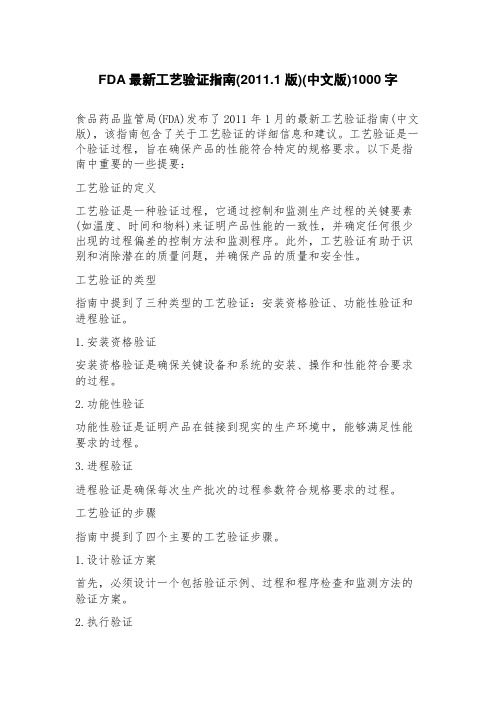
FDA最新工艺验证指南(2011.1版)(中文版)1000字食品药品监管局(FDA)发布了2011年1月的最新工艺验证指南(中文版),该指南包含了关于工艺验证的详细信息和建议。
工艺验证是一个验证过程,旨在确保产品的性能符合特定的规格要求。
以下是指南中重要的一些提要:工艺验证的定义工艺验证是一种验证过程,它通过控制和监测生产过程的关键要素(如温度、时间和物料)来证明产品性能的一致性,并确定任何很少出现的过程偏差的控制方法和监测程序。
此外,工艺验证有助于识别和消除潜在的质量问题,并确保产品的质量和安全性。
工艺验证的类型指南中提到了三种类型的工艺验证:安装资格验证、功能性验证和进程验证。
1.安装资格验证安装资格验证是确保关键设备和系统的安装、操作和性能符合要求的过程。
2.功能性验证功能性验证是证明产品在链接到现实的生产环境中,能够满足性能要求的过程。
3.进程验证进程验证是确保每次生产批次的过程参数符合规格要求的过程。
工艺验证的步骤指南中提到了四个主要的工艺验证步骤。
1.设计验证方案首先,必须设计一个包括验证示例、过程和程序检查和监测方法的验证方案。
2.执行验证执行验证时必须记录和监测所有的步骤和数据,特别是关键参数。
3.收集和分析数据通过收集和分析数据以确认生产过程的稳定性和一致性。
4.确定验证完成和维护验证状态一旦数据收集和分析完成,并验证的结果可以证明产品的一致性,就可以确定验证工作已经完成。
验证后,工厂必须确保维护验证状态,并定期进行监测。
总之,食品药品监管局(FDA)最新工艺验证指南(2011.1版)(中文版)提供了在生产过程中进行工艺验证的详细说明,这有助于确保生产的产品质量达到极高的水平,同时也有利于确保产品的安全性。
美国FDA指导原则药品不良反应上市后报告指南英文原版

美国FDA指导原则药品不良反应上市后报告指南英文原版Title: FDA Guidelines for Reporting Post-Market Drug Adverse ReactionsIntroductionThe U.S. Food and Drug Administration (FDA) plays a critical role in ensuring the safety and efficacy of drugs available in the market. One aspect of this responsibility is the monitoring and reporting of adverse reactions associated with the use of drugs post-marketing. This guideline aims to provide detailed instructions on how to report drug adverse reactions to the FDA.PurposeThe purpose of this guideline is to facilitate the reporting of adverse reactions associated with drugs that have been approved and are being used in the market. It enables healthcare professionals, consumers, and manufacturers to report adverse reactions promptly, thereby helping the FDA identify potential safety issues and take appropriate regulatory actions to protect public health.ScopeThe reporting of adverse reactions under this guideline applies to all prescription and non-prescription drugs,including biologics, vaccines, and generic drugs, indicated foruse in the United States. The guideline covers adverse reactions occurring both within and outside the United States.Reporting Requirements1. Mandatory Reporting: Manufacturers, packers, and distributors of drugs approved by the FDA must submit periodic safety reports containing information on any adverse drug reactions they receive.2. Voluntary Reporting:b. Consumers: Patients, caregivers, and other consumers can also report adverse reactions directly to the FDA using the MedWatch Reporting System.c. Foreign Regulatory Authorities: If an adverse reaction occurs outside the United States, foreign regulatory authorities are encouraged to report such events to the FDA.Reportable Events1. Serious Adverse Reactions: Any adverse reaction to a drug that results in death, a life-threatening condition, inpatient hospitalization or prolongation of existing hospitalization, persistent or significant disability, congenital anomaly, or requires intervention to prevent permanent impairment or damage.3. Adverse Reactions in Special Populations: Adverse reactions specific to particular populations, such as pregnantwomen, infants, elderly individuals, or individuals with certain medical conditions.4. Known Adverse Reactions: Adverse reactions that are already listed in the drug's labeling, but occur at a higher frequency or severity than expected.Reporting ProcessReporting adverse reactions involves the following steps:2. Submit the report electronically to the FDA through the MedWatch Reporting System.3. Include all available supporting documentation, such as laboratory test results, medical records, and any additional relevant information.Confidentiality and ProtectionConclusion。
美国FDA药品质量控制微生物实验室检查指南
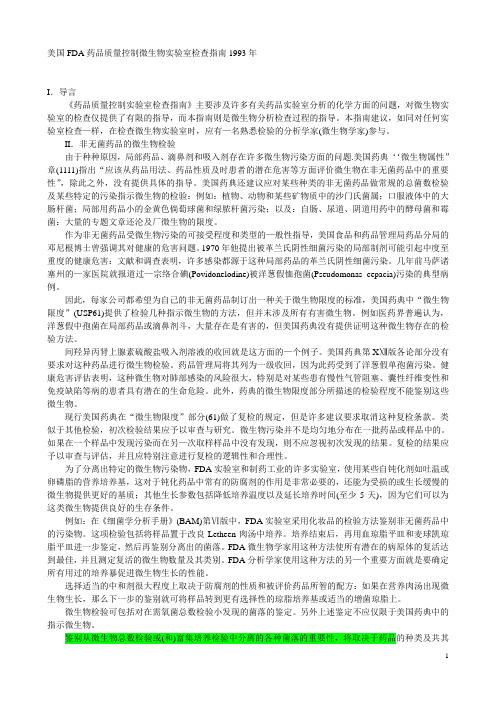
美国FDA药品质量控制微生物实验室检查指南1993年I.导言《药品质量控制实验室检查指南》主要涉及许多有关药品实验室分析的化学方面的问题,对微生物实验室的检查仅提供了有限的指导,而本指南则是微生物分析检查过程的指导。
本指南建议,如同对任何实验室检查—样,在检查微生物实验室时,应有—名熟悉检验的分析学家(微生物学家)参与。
II.非无菌药品的微生物检验由于种种原因,局部药品、滴鼻剂和吸入剂存在许多微生物污染方面的问题.美国药典‘‘微生物属性”章(1111)指出“应该从药品用法、药品性质及时患者的潜在危害等方面评价微生物在非无菌药品中的重要性”,除此之外,没有提供具体的指导。
美国药典还建议应对某些种类的非无菌药品做常规的总菌数检验及某些特定的污染指示微生物的检验:例如:植物、动物和某些矿物质中的沙门氏菌属;口服液体中的大肠杆菌;局部用药品小的金黄色倘萄球菌和绿脓杆菌污染;以及:自肠、尿道、阴道用药中的酵母菌和霉菌:大量的专题文章还沦及厂微生物的限度。
作为非无菌药品受微生物污染的可接受程度和类型的—般性指导,美国食品和药品管理局药品分局的邓尼根博士曾强调其对健康的危害问题。
1970年他提出被革兰氏阴性细菌污染的局部制剂可能引起中度至重度的健康危害:文献和调查表明,许多感染都源于这种局部药品的革兰氏阴性细菌污染。
几年前马萨诸塞州的—家医院就报道过—宗络合碘(Povidonelodine)被洋葱假恤孢菌(Pseudomonas cepacia)污染的典型病例。
因此,每家公司都希望为自己的非无菌药品制订出一种关于微生物限度的标准,美国药典中“微生物限度”(USP61)提供了检验几种指示微生物的方法,但并末涉及所有有害微生物。
例如医药界普遍认为,洋葱假中孢菌在局部药品或滴鼻剂斗,大量存在是有害的,但美国药典没有提供证明这种微生物存在的检验方法。
间羟异丙肾上腺素硫酸盐吸入剂溶液的收回就是这方面的—个例子。
美国药典第XⅫ版各论部分没有要求对这种药品进行微生物检验。
美国fda分析方法验证指南
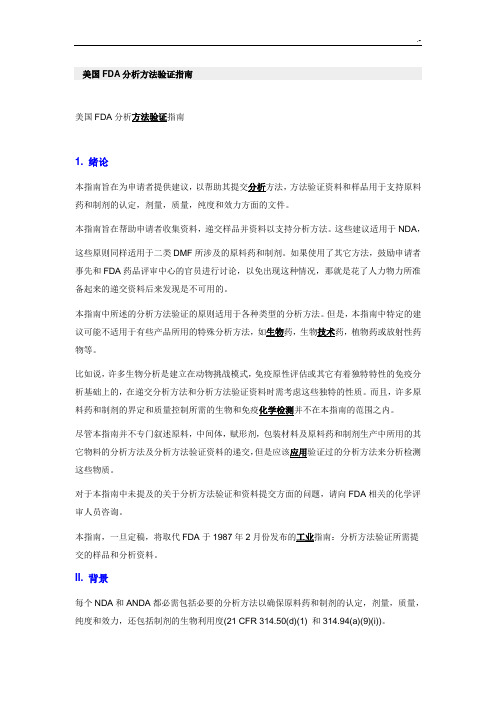
美国FDA分析方法验证指南美国FDA分析方法验证指南1. 绪论本指南旨在为申请者提供建议,以帮助其提交分析方法,方法验证资料和样品用于支持原料药和制剂的认定,剂量,质量,纯度和效力方面的文件。
本指南旨在帮助申请者收集资料,递交样品并资料以支持分析方法。
这些建议适用于NDA,这些原则同样适用于二类DMF所涉及的原料药和制剂。
如果使用了其它方法,鼓励申请者事先和FDA药品评审中心的官员进行讨论,以免出现这种情况,那就是花了人力物力所准备起来的递交资料后来发现是不可用的。
本指南中所述的分析方法验证的原则适用于各种类型的分析方法。
但是,本指南中特定的建议可能不适用于有些产品所用的特殊分析方法,如生物药,生物技术药,植物药或放射性药物等。
比如说,许多生物分析是建立在动物挑战模式,免疫原性评估或其它有着独特特性的免疫分析基础上的,在递交分析方法和分析方法验证资料时需考虑这些独特的性质。
而且,许多原料药和制剂的界定和质量控制所需的生物和免疫化学检测并不在本指南的范围之内。
尽管本指南并不专门叙述原料,中间体,赋形剂,包装材料及原料药和制剂生产中所用的其它物料的分析方法及分析方法验证资料的递交,但是应该应用验证过的分析方法来分析检测这些物质。
对于本指南中未提及的关于分析方法验证和资料提交方面的问题,请向FDA相关的化学评审人员咨询。
本指南,一旦定稿,将取代FDA于1987年2月份发布的工业指南:分析方法验证所需提交的样品和分析资料。
II. 背景每个NDA和ANDA都必需包括必要的分析方法以确保原料药和制剂的认定,剂量,质量,纯度和效力,还包括制剂的生物利用度(21 CFR 314.50(d)(1) 和314.94(a)(9)(i))。
FDA验证文件现场备查,可以不与DMF一起交。
必须要有资料来论证所用的分析方法是符合一定的准确度和可靠性标准的。
分析方法验证是论证某一分析方法适用于其用途的过程。
分析方法的验证过程是从申请者有计划地系统性收集验证资料以支持分析方法开始的。
质量量度要求-行业指南
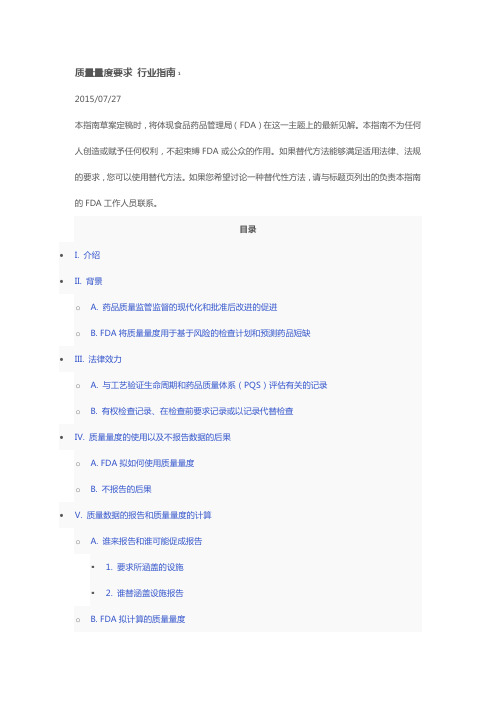
质量量度要求 行业指南 12015/07/27本指南草案定稿时,将体现食品药品管理局(FDA)在这一主题上的最新见解。
本指南不为任何人创造或赋予任何权利,不起束缚FDA或公众的作用。
如果替代方法能够满足适用法律、法规的要求,您可以使用替代方法。
如果您希望讨论一种替代性方法,请与标题页列出的负责本指南的FDA工作人员联系。
目录∙I. 介绍∙II. 背景o A. 药品质量监管监督的现代化和批准后改进的促进o B. FDA将质量量度用于基于风险的检查计划和预测药品短缺∙III. 法律效力o A. 与工艺验证生命周期和药品质量体系(PQS)评估有关的记录o B. 有权检查记录、在检查前要求记录或以记录代替检查∙IV. 质量量度的使用以及不报告数据的后果o A. FDA拟如何使用质量量度o B. 不报告的后果∙V. 质量数据的报告和质量量度的计算o A. 谁来报告和谁可能促成报告▪ 1. 要求所涵盖的设施▪ 2. 谁替涵盖设施报告o B. FDA拟计算的质量量度o C. 上报哪些质量数据o D. 质量数据向FDA报告的方式∙术语表∙附录A:质量量度数据提交说明∙数据工作表o产品特性信息o法定数据o可选量度I. 介绍药品行业广泛借助质量量度来监测质量控制体系和工艺,推动药品生产的持续改进。
FDA也可利用这些量度:制定合规及检查政策和规范,例如基于风险的药品生产商检查计划;强化FDA 预测并藉此减低未来药品短缺的能力;鼓励药品行业运用前沿、创新的药品质量管理体系。
本指南包括药品审评与研究中心(CDER)和生物制品审评与研究中心(CBER)计划如何收集数据并运用质量量度确保其政策和规范一如既往地支持药品工业的持续改进和创新的说明。
FDA了解,从事人用药品生产、制备、传代或加工,包括监督确保质量2等活动的设施,目前用质量量度作为其工艺验证生命周期和药品质量体系评价3的组成部分。
本指南概述了FDA有权要求设施所有人和运营者提供FDA根据联邦食品、药品与化妆品法案(简称为FD&C法案,或法案)第704节实施检查的记录和信息,并阐述了FDA拟向特定所有人和运营者要求的初步的要求组合。
FDA_Guidance(EnCh)
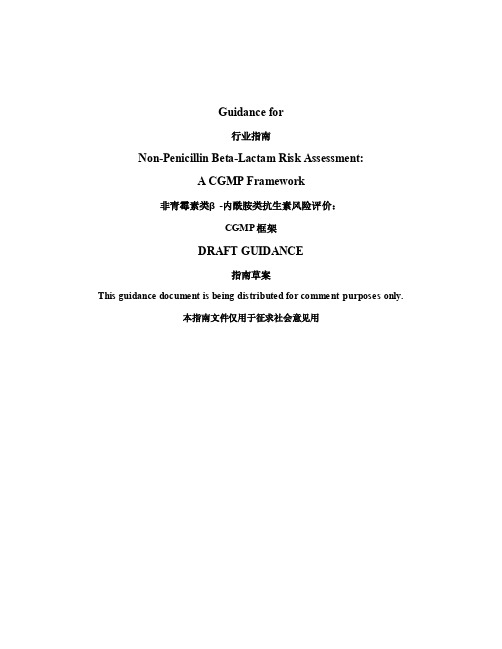
Guidance for行业指南Non-Penicillin Beta-Lactam Risk Assessment:A CGMP Framework非青霉素类β-内酰胺类抗生素风险评价:CGMP框架DRAFT GUIDANCE指南草案This guidance document is being distributed for comment purposes only.本指南文件仅用于征求社会意见用TABLE OF CONTENTS目录I. INTRODUCTIONI 简介II. BACKGROUNDII 背景III. RECOMMENDATIONSIII 建议I. INTRODUCTIONThis guidance describes the importance of implementing appropriate steps during the manufacturing process to prevent cross-contamination of finished pharmaceuticals and active pharmaceutical ingredients(APIs) with non-penicillin beta-lactam antibiotics. This guidance also provides information regarding the relative health risk of, and the potential for, cross-reactivity in the classes of sensitizing beta-lactam(penicillins and non-penicillin beta-lactams). This guidance is intended to assist manufacturers in assessing whether separate facilities should be used based on the relative health risk of cross-reactivity.本指南描述了在非青霉素类β-内酰胺类抗生素制剂与原料药生产过程中采取有效措施避免交叉污染的重要性。
FDA基因检测用药的指南

FDA基因检测用药的指南基因检测用药是一种个体化医疗策略,它通过检测患者的基因信息,为医生提供个性化的用药指导。
FDA(美国食品药品监督管理局)在这一领域发挥着重要的作用,其制定的指南对于基因检测用药的规范和安全性评估至关重要。
下面将详细介绍FDA在基因检测用药方面的指南。
首先,FDA在基因检测用药方面制定的指南包括了整个流程的规范。
从检测方法的选择到报告的解释和使用,FDA都提供了详细的指导。
在基因检测方法选择方面,FDA要求科研和开发人员要选择经过严格验证和认证的方法,以确保检测结果的准确性和可靠性。
在报告的解释和使用方面,FDA要求提供清晰、详细的结果解读,包括对药物相互作用、适应症、剂量调整等方面的指导。
其次,FDA的指南还强调了基因检测用药的安全性评估。
基因检测用药涉及到个体化用药和新兴的治疗策略,因此其安全性评估尤为重要。
FDA要求科研和开发人员应开展临床实验以评估基因检测用药的安全性和有效性。
在药物治疗方面,FDA要求进行临床试验来评估不同基因型患者的用药反应和不良反应风险。
在基因检测方法方面,FDA要求开发人员评估基因检测方法的准确性、重复性和可靠性,并提供相关数据以支持其使用。
此外,FDA的指南还涉及基因检测用药的数据分析和解读。
基因检测用药的数据分析复杂且具有个体差异性,因此需要科研和开发人员具备相关的专业知识和经验。
FDA要求科研和开发人员在数据分析和解读过程中要严格遵守标准化的操作程序,并提供相关的技术规范和标准。
此外,FDA还鼓励科研和开发人员进行数据共享和合作,以促进基因检测用药领域的发展和进步。
最后,为了保障基因检测用药的准确性和可靠性,FDA还制定了相关的质量控制标准。
基因检测用药是一项高科技的医疗技术,需要严格的质量控制来确保结果的准确性和可靠性。
FDA要求科研和开发人员对基因检测用药的每个环节进行质量控制,并保留相关的质量控制记录和数据。
此外,FDA还对基因检测用药的设备和试剂品质量标准进行了规定,以确保基因检测用药的质量和安全性。
《基因治疗产品长期随访临床研究技术指导原则(征求意见稿)解读

一、为何制定基因治疗产品长期随访专门指南?基因治疗:是指通过修饰或操纵基因的表达或改变活细胞的生物学特性以达到治疗目的的治疗手段,主要作用机制有正常基因替换致病基因、使不能正常工作的基因失活或者引入新的或修饰的基因等方式。
活细胞的生物学特性这些变化在体内长期存在,可能增加不可预测的风险。
为了评估和降低这类风险,并了解治疗效果随时间延长的变化,有必要对参加基因治疗临床试验的受试者开展长期随访。
基因治疗产品长期随访的主要目的是收集受试者的迟发性不良反应,了解基因治疗产品在体内的存续情况,从而识别并降低接受基因治疗产品的患者的长期风险。
此外,考虑到基因治疗产品长期作用的特点,观察疗效随时间的变化情况也是长期随访的重要目的。
目前,美国FDA和欧盟EMA均已发布相关技术指导原则,经查询,欧盟EMA于2010年发布的《有关基因治疗产品给药后患者随访的指南(Guideline on follow-up of patients administered with gene therapy medicinal products)》指南;美国FDA于2020年1月发布的《人类基因治疗产品给药后的长期随访(Long-term Follow-up After Administration of Human Gene Therapy Products)》指南,考虑到国内尚无相关指导原则对基因治疗产品长期随访临床试验设计进行规范指导,CDE在充分调研国内外同品种研发情况以及相关临床试验技术要求基础上,起草了《基因治疗产品长期随访临床研究技术指导原则(征求意见稿)》。
二、基因治疗产品长期随访观察时间梳理长期随访的持续时间应确保足以观察到受试者因产品特性、暴露情况(生物分布和给药途径)等导致的风险,应不短于迟发性不良反应的预期发生时间。
具体产品的随访时间取决于产品的特性和体内存在时间、转基因表达时间、迟发性不良反应的预期时间及发生率、受试者适应症和预期生存期、给药途径、以及长期随访的其他观察目的。
FDA发布药物诊断共同开发的指南草案
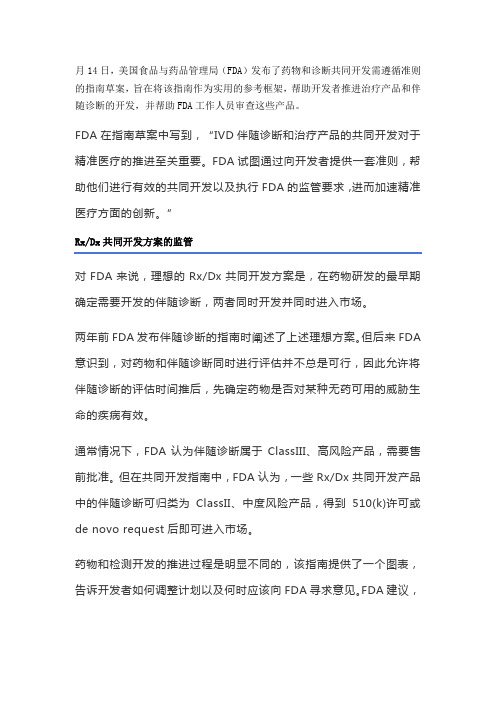
月14日,美国食品与药品管理局(FDA)发布了药物和诊断共同开发需遵循准则的指南草案,旨在将该指南作为实用的参考框架,帮助开发者推进治疗产品和伴随诊断的开发,并帮助FDA工作人员审查这些产品。
FDA在指南草案中写到,“IVD伴随诊断和治疗产品的共同开发对于精准医疗的推进至关重要。
FDA试图通过向开发者提供一套准则,帮助他们进行有效的共同开发以及执行FDA的监管要求,进而加速精准医疗方面的创新。
”Rx/Dx共同开发方案的监管对FDA来说,理想的Rx/Dx共同开发方案是,在药物研发的最早期确定需要开发的伴随诊断,两者同时开发并同时进入市场。
两年前FDA发布伴随诊断的指南时阐述了上述理想方案。
但后来FDA 意识到,对药物和伴随诊断同时进行评估并不总是可行,因此允许将伴随诊断的评估时间推后,先确定药物是否对某种无药可用的威胁生命的疾病有效。
通常情况下,FDA认为伴随诊断属于ClassIII、高风险产品,需要售前批准。
但在共同开发指南中,FDA认为,一些Rx/Dx共同开发产品中的伴随诊断可归类为ClassII、中度风险产品,得到510(k)许可或de novo request后即可进入市场。
药物和检测开发的推进过程是明显不同的,该指南提供了一个图表,告诉开发者如何调整计划以及何时应该向FDA寻求意见。
FDA建议,开发者需对治疗和诊断的研发都有一定的了解,并且治疗和诊断研发双方都要出席与FDA药物和诊断部门的会议。
FDA对伴随诊断的定义是,一种必需的验证药物安全性和有效性的检测。
因此,FDA建议,伴随诊断(CDx)的性能分析需在它应用在药物的临床试验前进行。
当没有足够的数据证明一种试验性新药对患者的风险时,FDA会对这项研究下达“clinical hold(临床试验暂停)”通知。
但FDA表示,伴随诊断性能分析的不确定性不会导致这种暂停。
如果一种药物的伴随诊断之前未得到FDA批准用于这种特定用途,开发者必须提出申请并获得器械临床研究豁免(IDE)。
FDA指南草案(中文)
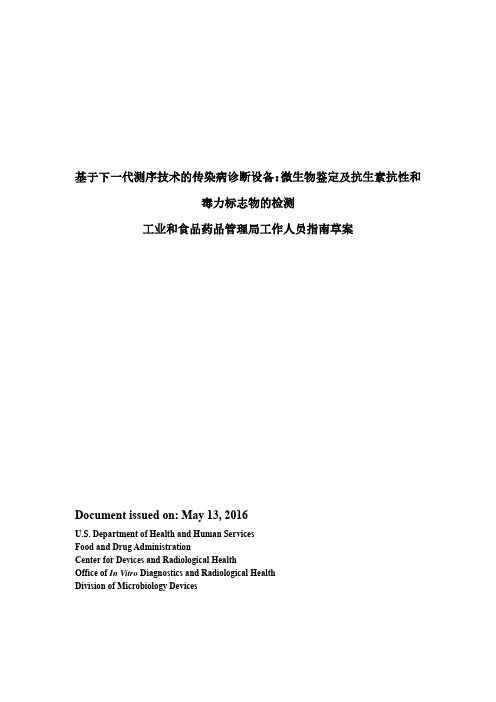
基于下一代测序技术的传染病诊断设备:微生物鉴定及抗生素抗性和毒力标志物的检测工业和食品药品管理局工作人员指南草案Document issued on: May 13, 2016U.S. Department of Health and Human ServicesFood and Drug AdministrationCenter for Devices and Radiological HealthOffice of In Vitro Diagnostics and Radiological HealthDivision of Microbiology Devices目录I.简介 (1)II.背景 (1)A.传染病NGS Dx设备的系统方法 (2)B.FDA-ARGOS: FDA监管级微生物序列数据库 (2)III.范围 (3)IV.利弊分析 (5)V.设备描述 (5)A.预期用途 (5)B.测试方法学 (6)C.辅助试剂 (7)D.控制 (8)(1)阴性对照 (8)(2)阳性对照 (9)(3)内部对照 (9)E.试验结果和报告的解释 (10)VI.设备验证 (10)A.预分析因素 (11)(1)样本收集和处理 (11)(2)样本准备和测序 (12)(3)测序、化学过程和数据收集 (12)(4)数据储存 (13)(5)临床决策要求 (13)B.感染性疾病NGS Dx设备性能指标 (13)(1)感染性疾病NGS Dx设备数据集 (14)(2)测序策略 (14)(3)用于靶向鉴定的参考序列和所选的靶标 (14)(4)临床识别信息学工序流程 (15)(5)减法原理 (15)(6)质量控制 (15)(7)测序及序列比对 (15)(8)污染分析 (15)(9)感染性疾病NGS Dx设备应当提供从样本到结果的周期 (16)(10)数据存储 (16)C.分析性能 (17)(1)检测极限 (17)(2)包容性 (17)(3)干扰物质 (18)(4)精确(可重现性及可重复性) (19)(5)携带及交叉污染 (19)(6)稳定性 (19)(7)其他分析性实验 (19)D.仪器和软件 (19)E.临床评估 (21)(1)阴性百分比一致性评价 (21)(2)阳性百分比一致性评价 (22)(3)数据展示 (23)(4)样本研究和样本类型 (23)Ⅶ设备调试 (24)基于下一代测序技术的传染病诊断设备:微生物鉴定及抗生素抗性和毒力标志物的检测工业和食品药品管理局工作人员指南草案I.简介美国食品药品监督管理局(FDA)发布该指南草案是为工业和机构工作人员提供建议,以研究建立基于下一代测序的用于分析传染病临床表现特征的微生物鉴定及抗生素耐药性和毒力标志的检测设备(以下简称“传染病NGS Dx设备”)。
- 1、下载文档前请自行甄别文档内容的完整性,平台不提供额外的编辑、内容补充、找答案等附加服务。
- 2、"仅部分预览"的文档,不可在线预览部分如存在完整性等问题,可反馈申请退款(可完整预览的文档不适用该条件!)。
- 3、如文档侵犯您的权益,请联系客服反馈,我们会尽快为您处理(人工客服工作时间:9:00-18:30)。
Public Notification of Emerging1Postmarket Medical Device Signals 2(“Emerging Signals”)3______________________________________________________________________________ 4Draft Guidance for Industry and 5Food and Drug Administration Staff 67DRAFT GUIDANCE89This draft guidance document is being distributed for comment purposes only. 1011Document issued on December 31, 2015.1213You should submit comments and suggestions regarding this draft document within 60 days of14publication in the Federal Register of the notice announcing the availability of the draft15guidance. Submit electronic comments to . Submit written comments 16to the Division of Dockets Management (HFA-305), Food and Drug Administration, 563017Fishers Lane, rm. 1061, Rockville, MD 20852. Identify all comments with the docket number18listed in the notice of availability that publishes in the Federal Register.1920For questions about this document, contact the Office of Communication and Education, 301-21796-5660 or the Office of Surveillance and Biometrics, 301-796-6006.22232425262728U.S. Department of Health and Human Services 29Food and Drug Administration 30Center for Devices and Radiological Health 31Office of Communication and Education 32Office of Surveillance and Biometrics 3334Preface3536Additional Copies3738Additional copies are available from the Internet. You may also send an e-mail request to CDRH-39Guidance@ to receive a copy of the guidance. Please use the document number401500027 to identify the guidance you are requesting.4142Public Notification of Emerging43Postmarket Medical Device Signals 44(“Emerging Signals”)4546474849505152535455565758596061626364656667686970information. This draft guidance document proposes criteria, timeframes, a method of71communication, and follow-up for FDA communications for emerging signals. This document 72does NOT address findings of postmarket safety or reduced benefit that are confirmed, or for73which the Agency has specific recommendations for consumers, patients, health care providers, 74health care facilities, or industry.7576Historically, the FDA has communicated important medical device postmarket information after 77having completed an analysis of available data and, in most cases, after having reached a78decision about relevant recommendations for the device user community and about whether79further regulatory action is warranted. For such safety or effectiveness issues, FDA generally will 80provide new or amended advice or instructions for patients, practitioners, and/or consumers81regarding the safe and effective use of the device, based on the new data. In these cases, the82Agency uses a variety of mechanisms to communicate publicly, including recall notices, safety 83communications, and press releases.8485However, in addition to these types of public communications, we believe there also is a need to 86notify the public about emerging signals that the Agency is monitoring or analyzing, even when 87the information has not been fully analyzed, validated or confirmed, and for which the Agency 88does not yet have specific recommendations.8990Because of the evolving nature of this information, FDA would be sharing it with the public at an 91early stage of the Agency’s assessment and evaluation of the signal. Further, in contrast to a92device safety communication, a communication regarding an emerging signal may lack certainty 93about the significance of the information, including whether it represents a new, potentially94causal association, or a new aspect of a known association (e.g., increased rate or severity of95event), between a medical device and one or more adverse events or outcomes.9697Timely communication about emerging signals is intended to provide health care providers,98patients, and consumers with access to the most current information concerning the potential99benefits and risks of marketed medical devices so that they can make informed treatment choices 100based on all available information. Such communication may also reduce or limit the number of 101patients exposed to the potential risk while the issue is being further evaluated. In addition,102communicating emerging signals may also promote enhanced vigilance on the part of clinicians, 103risk managers, patients and consumers, who may respond by increasing their reporting to FDA. 104This may in turn assist the Agency in further understanding the emerging signal.105106FDA’s guidance documents, including this draft guidance, do not establish legally enforceable 107responsibilities. Instead, guidances describe the Agency’s current thinking on a topic and should 108be viewed only as recommendations, unless specific regulatory or statutory requirements are109cited. The use of the word should in Agency guidances means that something is suggested or110recommended, but not required.111II.Background112All medical devices have benefits and risks. Health care providers, patients, and consumers must 113weigh these benefits and risks when making health care decisions. FDA weighs probable benefit 114to health from the use of the device against any probable risk of injury or illness from such use in 115determining the safety and effectiveness of a device.1 However, not all information regarding 116benefits and risks for a given device may be fully known or characterized prior to the device117reaching the market. New information about the safety and/or effectiveness of the device often 1181See 21 U.S.C. 360c(a)(2) and 21 C.F.R. 860.7.becomes available once the device is more widely distributed and used under real-world119conditions of actual clinical practice.120121The FDA strives to provide current information concerning the potential benefits and risks of 122marketed medical devices to health care providers, patients, and consumers so that they can123make informed treatment choices based on all available information.2 We also recognize the 124potential unintended consequences of public communication about emerging signals, prior to 125confirmation and full evaluation of the data, including the possibility that a beneficial device’s 126use may be avoided or inappropriately stopped because of uncertain or unproven risks or127uncertainty around the benefits. This latter concern is particularly relevant when the Agency has 128not yet developed specific recommendations. However, FDA believes that when an emerging 129signal meets the criteria described in Section III, including that it is based on reliable data, the 130benefits of providing early information to the public outweigh these risks if communicated131carefully and thoughtfully.132133Emerging signals may include, but are not limited to, a newly recognized type of adverse event 134associated with a medical device, an increase in the severity or frequency of reporting of a135known event, new product-product interactions, device malfunctions or patient injuries136potentially related to improper device use or design, or a reduction in benefit to the patient. A 137medical device emerging signal may be associated with one product from one manufacturer, one 138type of product or similar products from multiple manufacturers, or multiple different product 139types from multiple different manufacturers (e.g., materials issues).140141The gathering and interpretation of the additional data needed to fully characterize an emerging 142signal can be complex, and it may take weeks or months to conduct the analyses to understand 143the implications of the signal for device performance and for its clinical significance. In addition, 144in certain circumstances, the FDA may collaborate with other federal and state public health145agencies, or elect to seek recommendations from one of its Advisory Committees to assist in146evaluating available information pertaining to a signal. These factors contribute to variability in 147the amount of time needed to sufficiently evaluate an emerging signal and to determine whether 148public communication of specific recommendations and/or regulatory action are warranted.149III.Considerations for Determining When FDA Will Issue a 150Public Notification About an Emerging Signal151FDA considers many factors in the course of evaluating and communicating about medical152device emerging signals. These factors may include, but are not limited to, the following:153154·Seriousness of the adverse event(s) (e.g., severity and reversibility) relative to the known 155benefits of the device;1562 FDA discloses such information pursuant to all applicable laws, regulations, and policies, including sections 301(j)and 520(c) of the Federal Food, Drug, and Cosmetic Act, the Trade Secrets Act, the Privacy Act, and FDAdisclosure regulations.·Magnitude of the risk (e.g., likelihood of occurrence);157·Magnitude of the benefit;158·Strength of the evidence of a causal relationship between the use of a device and the159adverse event;160·Extent of patient exposure (e.g., how broadly is the device used, is the device still161actively manufactured and distributed);162·Whether there is a disproportionate impact on vulnerable patient populations (e.g.,163children, pregnant women, elderly, cancer patients, chronically ill, at-164home/unmonitored);165·Potential for preventing, identifying, monitoring or mitigating the risk;166·Availability of alternative therapies;167·Implications for similar or related devices (e.g., multiple models from multiple168manufacturers);169·Anticipated time for completion of initial FDA assessment and development of170recommendations;171·Accuracy and availability of information already in the public domain.172173At times, the decision to communicate about a medical device emerging signal may be affected 174by information the public has received from sources other than FDA, such as in the mainstream 175or social media. In some cases, the safety of a particular medical device or type of device may be 176publicly questioned based on incorrect, incomplete, or misleading information. In such cases, 177FDA may issue a statement or engage in other methods of communication to clarify or correct 178information and respond to public interest.179180The decision to provide public information about a medical device emerging signal is intended to 181give health care providers, patients and consumers access to the most current information about 182an emerging signal. It does not mean that FDA has concluded that there is a causal relationship 183between the medical device and the emerging signal. Nor does communicating about the184emerging signal mean that FDA is advising health care providers, patients, or consumers to limit 185their use of the device.186187Whenever FDA discusses medical device safety, it should exercise judgment in determining188whether and when to communicate and what to say. FDA staff should strongly consider public 189communication about an emerging signal when all of the following statements apply:1901911.the information represents a new, potentially causal association, or a new aspect of a192known association (e.g., increased rate or severity of event or reduced benefit), between a 193medical device and one or more adverse events or clinical outcomes;1942.the available information is reliable and supported by sufficient strength of evidence; and 1953.the information could have important clinical implications for patient management196decisions and/or could it significantly alter the known benefit-risk profile of the device. 197198FDA staff should conduct an initial assessment of the need to communicate about an emerging 199signal within 30 days of receiving the information.200201If during the evaluation of a signal, a decision is made to NOT communicate, FDA staff should 202conduct an internal reassessment of the decision within 30 days of receiving new information, 203using the considerations described above.204IV.Content of Communication and Follow-up205FDA strives to keep all communications clear and understandable. We consider elements of206human behavior in our decision to communicate and in the content of our communication. We 207realize that risk information provided without context may alarm patients, causing them to208discontinue therapy with a beneficial device or to avoid a potentially beneficial therapy. In our 209communications on medical device emerging signals, whenever possible and appropriate, we will 210include specific information on the known benefits and risks of the device and its use, as well as 211information on the emerging signal.212213To provide consistency, FDA proposes to communicate medical device emerging signals using 214the format and content described in Appendix A of this guidance. Once a medical device215emerging signal is communicated, the Agency may provide updates that:216217·Provide new information related to the emerging signal collected since the initial public 218notification;219·Update the public that no additional substantive information is available and/or that no 220known change in the benefit-risk profile of the device has occurred since the last posting; 221·Notify the public of additional actions being taken or completed by FDA and/or the222manufacturer(s).223224Updates to the communication should be posted to the FDA website at least twice per year, or 225more often as necessary and appropriate, until either the Agency issues a more formal “Safety 226Communication” containing specific recommendations for patients, health care providers, and/or 227health care facilities, or until the signal evaluation is otherwise completed and the public is228notified of the Agency’s conclusions.229230Appendix A: Format of Public Notification about a Medical 231Device Emerging Signal232233Early Communication: FDA Evaluating [summary of issue]234235This communication reflects FDA’s current assessment of available information about [issue]. It 236is intended to highlight this information at an early stage in the FDA’s review, before the FDA 237has completed a full investigation or determined whether this information warrants regulatory 238action. Posting this information does not mean that FDA has concluded there is a causal239relationship between the medical device and the emerging signal. Nor does it mean that the FDA 240is advising patients or health care professionals to discontinue or modify use of these products. 241The FDA will update this document when additional information or analyses become available. 242243Date:244Device (including known benefits and risks):245Summary of Emerging Signal:246Additional Information for Patients and Health Care Professionals (if any):247Ongoing FDA Actions:248How to Report Problems to the FDA:249250。
